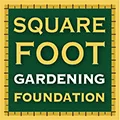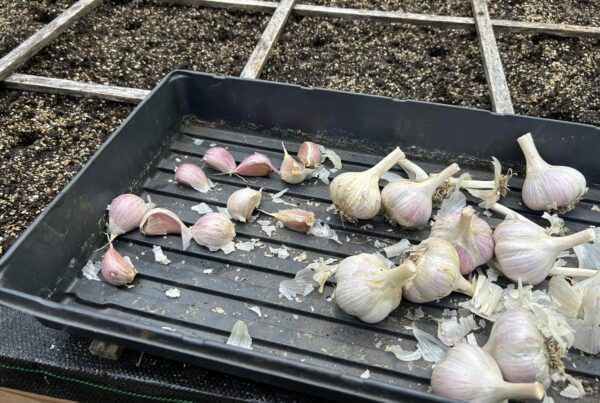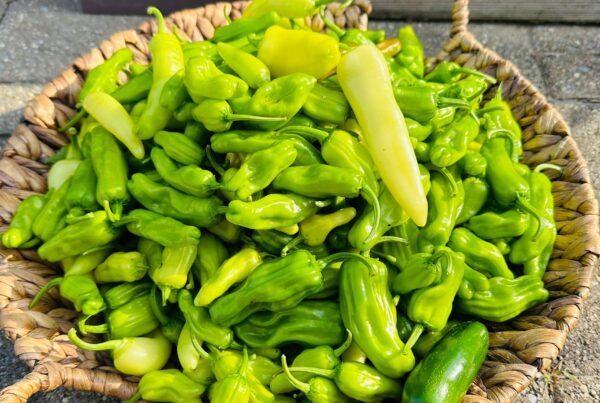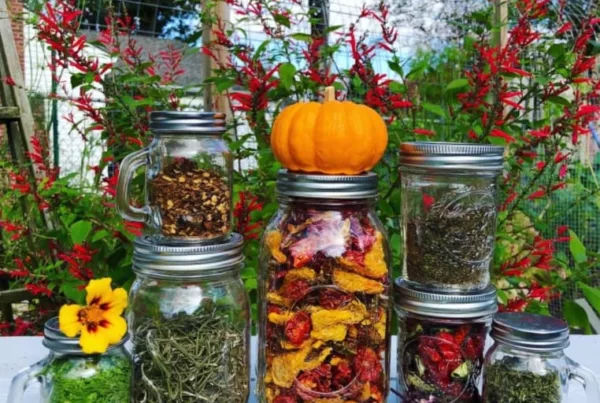Written by Chris McLaughlin
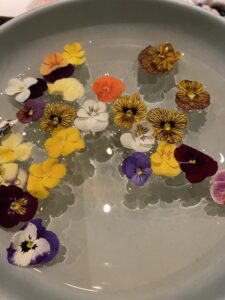 Would it surprise you to know that flowers pair perfectly with your favorite culinary dishes? Edible flowers can be used in salads, soups, pastas, pizzas, sauces, omelets, salad dressings, vegetable dishes, bean dishes, and rice dishes. They are often candied or used in baked goods like cakes, cookies, syrups, and artisan sugars. Some of your favorite garden blossoms make flavorful additions added to jellies, butter, oils, vinegars, and flavored wines. Edible flowers are popular in teas, ice cubes, and make beautiful garnishes for summer drinks.
Would it surprise you to know that flowers pair perfectly with your favorite culinary dishes? Edible flowers can be used in salads, soups, pastas, pizzas, sauces, omelets, salad dressings, vegetable dishes, bean dishes, and rice dishes. They are often candied or used in baked goods like cakes, cookies, syrups, and artisan sugars. Some of your favorite garden blossoms make flavorful additions added to jellies, butter, oils, vinegars, and flavored wines. Edible flowers are popular in teas, ice cubes, and make beautiful garnishes for summer drinks.
The list of plants that produce edible flowers is endless. However, the flowers listed here are great candidates for space in your Square Foot Garden bed! In fact, some of these blossoms belong to familiar herbs that you already grow. Plant these edible flowers among your veggies or give them their own SFG bed, especially if they are perennial plants.
- Basil (Ocimum basilicum) – Basil flowers carry that spicy basil flavor but much milder than the leaves. Annual.
- Bee Balm (Monarda didyma) – Monarda’s flowers taste like oregano. Perennial.
- Borage (Borago officinalis) – These flowers have a cucumber and honey flavor. Annual.
- Calendula (Calendula officinalis) – Calendula flowers have a tangy, peppery, mildly bitter flavor. Annual.
- Chives (Allium schoenoprasum) – Chive blossoms have a light onion flavor. Perennial.
- Cornflower (Centaurea cynaus) – Flowers are mostly mild, nondescript, and slightly sweet. Annual.
- Dianthus – (Dianthus) – These flowers have a spicy, clove-like flavor. Both annual and perennial species.
- English chamomile (Chamaemelum nobile) – Chamomile blossoms are earthy with notes of sweet apple. Perennial.
- Hollyhock (Alcea rosea) – These blossoms have a mild to slight anise flavor. Both biennial and perennial species.
- Johnny-Jump-up (Viola) – Viola flowers have a light mint, slightly sweet flavor. Perennial.
- Lavender (Lavendula) – lavender has a strong floral flavor with hints of rosemary and mint. Perennial.
- Lovage (Levisticum officinale) – These flower petals have a mild celery flavor. Perennial.
- Marigold (Tagates erecta & T. patula) – Marigolds have a peppery, citrus, anise flavor. Annual.
- Mint (Mentha)– Mint flowers have a fresh flavor that is milder than their leaves. Perennial.
- Nasturtiums (Tropaeolum majus) These have a peppery taste backed by a little watercress flavor. Annual.
- Primrose (Primula vulgaris) – The blossoms have a sweet, refreshing flavor. Perennial.
- Scented Geranium (Pelargonium graveolens) – The flavor will depend on the variety of geranium such as lemon, chocolate, rose, etc. Both annual and perennial.
- Squash Blossoms (Curcurbita pepo) – These flavor blossoms’ flavor resembles sweet radish. Annual.
- Summer (Satureja hortensis) & Winter Savory (Satureja montana) – Both flowers from these herbs are slightly peppery. Summer savory is an annual, while winter savory is a perennial.
- Sunflower (Helianthus annus) – Sunflower petals have a mild, bittersweet, nutty flavor. Annual.
- Zinnia (Zinnia elegans) – Zinnias have a rather bitter flavor and seem best used as a garnish. Annual.
Harvesting Flowers for the Kitchen
Let’s go over the three indisputable rules of harvesting edible plants:
- Only choose flowers that come from plants that you can 100% identify as an edible plant or flower.
- Only the parts of a plant that are known to be safe for human consumption should be eaten.
- Never harvest flowers that you plan on eating that have been sprayed with pesticides or herbicides.
Edible Flower Ice Pops
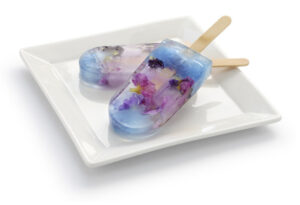 You’ll want to skip the old, faded blooms and choose flowers that are fresh with good color. And although it is not entirely necessary, remove everything but the petals for culinary use. Enjoy your blooming edibles!
You’ll want to skip the old, faded blooms and choose flowers that are fresh with good color. And although it is not entirely necessary, remove everything but the petals for culinary use. Enjoy your blooming edibles!
Note: The edible flowers must not have been treated with any pesticides. Some edible flowers include rose petals, nasturtiums, pansy and/or viola flowers, marigold flowers, and chive flowers.
Rose Syrup*:
• ½ cup sugar
• ½ cup water
• 1 teaspoon rosewater
For the Rose Syrup: Combine the sugar and water over medium heat, stirring until the sugar dissolves. Lower the heat and simmer 5 minutes. Remove the pan from the heat and stir to add the rosewater. Cool completely.
Popsicles:
• 2 cups coconut water (make sure you get coconut water—not canned
coconut milk or cream)
• ¼ cup rose syrup*
• edible flowers
• popsicle molds (or paper cups) and popsicle sticks
Stir together the coconut water and rose syrup. Place 3 to 5 flowers into each popsicle mold and fill with the coconut water-rose syrup mixture. Freeze until the pops are completely solid. Take the pretty popsicles out of their mold and enjoy.
